Seeking to improve its portable devices, Apple has applied for a patent that could lead to touch-sensitive Macs or handhelds which react to the level of force, rather than just contact.
Originally submitted in March of last year but only published on Thursday, the patent for a "Force Imaging Input and Device System" describes today's touchscreens and touchpads as limited by their relatively simple input, which tracks just the location of the finger or stylus on the surface. A method of detecting the strength of the user's input would add a new element of control, according to Apple.
"One drawback to using touch pads as input devices is that they do not generally provide pressure or force information," the company writes. "Force information may be used as another input dimension for purposes of providing command and control signals to an associated electronic device."
To solve the problem, the patent's inventors Brian Huppi and Steven Hotelling have suggested lining touchpads with a set of traces joined together by a sandwich-like spring membrane layer underneath the surface. Touching the pad would deform the traces and create a capacitive image in circuitry, indicating where contact has been made.
But unlike traditional capacitive or resistive touch surfaces, the membrane would help create a second image that recognizes just how much pressure has been applied at a given point; the harder the user pushes, the closer the membrane reaches conductive elements inside the layer and the more force would be registered with each press.

Though Apple's patent application primarily describes a touchpad like those used for the company's MacBook lines, one variant mentioned in the document would also allow for an LCD touchscreen with the same features, raising the possibility of an iPhone or other touch-sensitive computer with the new control scheme. Computers, phones, PDAs, and control panels are listed as candidates for the technique, although Apple is not obliged to manufacture any products using its invention.
Importantly, however, the company notes that the system would recognize more than one source of input at the same time, allowing the firm's existing multi-touch system to work with the pressure-sensitive feature intact. Apple goes so far as to reference an older patent for a "Multipoint Touch Screen," one of the cornerstones of its iPhone technology, as supporting evidence for its new control method.


